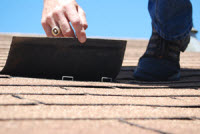Replacing the roof of your home can be an extremely expensive endeavor costing thousands of dollars.
Which makes it a good idea to do everything you can to make that roof you have last as many years as possible. Doing something as simple as inspecting your roof twice a year can help you find small problems and get them fixed before they become big problems that requires the expertise of a professional roofer and an entire new roof. Learning what to look for when inspecting your roof can save you a lot of money and headaches as well.
The Best Time To Inspect Your Roof
A complete inspection of your roof should be done twice a year. In the spring immediately after the snow melts and again in the fall before winter hits. Smaller and quicker inspections should be done after a large storm with a lot of wind.
Start With An Inside Inspection
Your roof inspections should actually begin on the inside of your home. You should walk around your house and check all the corners to make sure that there are no bulges or stains left by water. Make sure that you look in the closets as well as main living areas.
If you have an attic or crawl space you should make sure to inspect this area. Look for any damp spots or signs of leakage. Inspect the tiles to see if they show signs of water damage and if possible check any fiberglass insulation for sagging or dampness. If there is any signs of water on the inside of your home chances are good that there has been damage to your roof. If there is no inside damage you still need inspect the outside of your roof.
Inspecting Your Roof From the Outside
You should start your inspection of your roof from the outside simply by standing in various places around your house and looking up at your roof. Look for:
- Any overhanging tree branches as these pose a hazard and should be trimmed back before they cause damage.
- Look for any debris on the roof as this will need to be removed, and the area checked for damage.
- You should also look for any missing, broken, worn or loose tiles or shingles, bare spots on gravel roofs or rust spots on metal roofs. Also note any tiles or shingles that don’t seem to be lying flat as they should. These will all need to be inspected closer or replaced.
- Walk around the entire outside of your house and check the fascia board and soffits and make sure that they are in good repair.
- You will also want to check the edge metal to make sure it is unbent and in place.
Once you have completed this you are ready to do a closer inspection of your roof using binoculars or a ladder. A ladder works best as it gets you on height with the roof so that you can see things better.
- Check the gutters and rain spouts and make sure they are free of debris and in good repair.
- Check all the flashings as well.
- If you have a shingled roof look over the shingles well and make sure that none of the shingle nail are sticking up or missing. If they are these will need to be replaced and sealed. For those with gravel type roofs look for any spots where the gravel has worn off or is thin.
- Look for any black spots that may mean mold or mildew has begun to take hold.
- Make sure that the valleys are well sealed.
- Check the mortar around all chimneys and parapet walls for cracks or lose mortar.
- Check and see if the any tar paper is visible.
When inspecting your roof, make note of any problems that you find and where they are located. Remember not to walk on your roof unless it is absolutely necessary to do to make repairs or to inspect something you are unable to view any other way. As walking on the roof can cause further damage to it.
Once you have completed all your repairs, then you should do one more inspection looking for anything you might have missed. While this may be somewhat time consuming it will be better in the long run than having to replace your roof because you overlooked what seemed to be a minor concern.
By inspecting your roof twice a year and knowing what to look for when you do your inspections you can help to increase the life span of your roof by several years in many cases. In addition, you can rest assured that your home and your family is well protected from the damage that can be caused by poor or damaged roofing.

